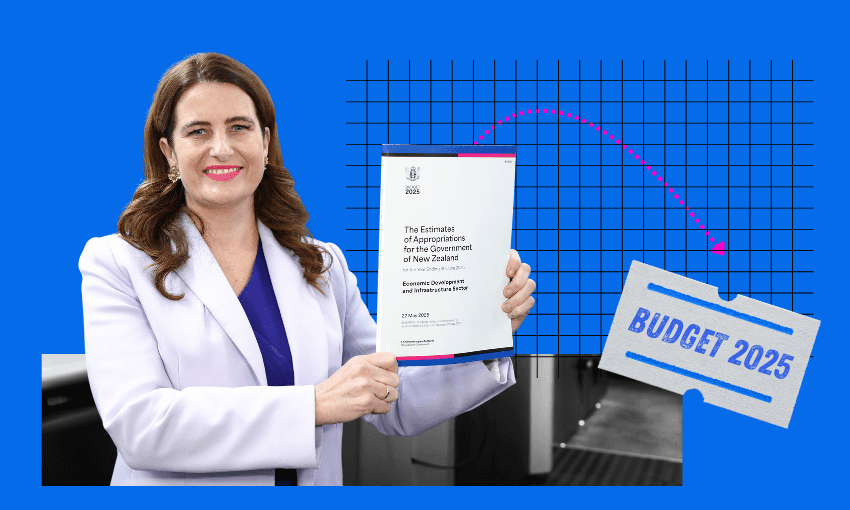Nicola Willis’s second budget delivers tax incentives for businesses, changes to KiwiSaver, and more cuts across the board.
Our Budget 2025 reporting is thanks to The Spinoff Members. The Spinoff is not backed by billion-dollar budgets or billionaires, we’re backed by you. To meet our current goal, we need 500 new members by the end of June. Please donate now.
- Government contribution halved for all KiwiSaver account holders, cut entirely for those earning above $180,000. Employer and employer default contribution rates rising.
- First year of BestStart will be income tested as the second and third years are, with payments cutting off for a family earning just over $97,000 annually.
- Changes to the pay equity scheme are forecast to save the government $10.97 billion over four years.
- A new tax incentive allows businesses to immediately deduct 20% of the cost of new assets from taxable income, on top of the existing depreciation write-offs.
The Budget 2025 festivities began on Wednesday with the traditional photo op at Blue Star printing plant in Petone. Media packed into a warm room that smelled of ink and glue to watch some A3 pages come out of a giant printer. Nicola Willis and Chris Bishop arrived, mobbed by a pack of cameras, and held the document aloft like celebrity authors at the world’s worst book launch. The front page was punishingly dull: The Estimates and Appropriations of the Government of New Zealand for the Year Ending 30 June 2026.
They stood side by side, beaming proudly, until a photographer asked for “one with just the finance minister”. Bishop sulked away, “I know when I’m not wanted.” Willis held her smile for the cameras, quipping “got what you need? This has got what you need” and “No BS in here. No rainbows and unicorns either.”
Here’s what the important documents contained:
KiwiSaver changes call for more employer/ee contributions
One of the major announcements is a revamp of KiwiSaver, with employers and employees now expected to make higher contributions to their KiwiSaver as the government halves its contributions to 25 cents to every member dollar (to a new maximum of $260.72 annually). There is also a sliver of means testing (always a hot potato on superannuation-related matters) introduced to KiwiSaver, with the government contribution (up to $521) scrapped for those earning $180,000 or more a year. Eligibility will be assessed according to one of the two last tax years. The KiwiSaver contribution changes will save $2.47 billion over four years.
From April 1, 2026, the default contribution rate for employees/ers will rise from 3% to 3.5%, then 4% from April 1, 2028. There are 3.3 million KiwiSaver accounts across the country, two million of which receive contributions at any given time, and roughly 5% in suspended contributions. As of 2024, 3.4% of wage and salary earners in New Zealand earned $180,000 or more.
Willis told reporters the three-year phasing period gave businesses “time to prepare” for change, and she did not expect the changes to hurt small business. “I think this is a budget that is very good for employers,” Willis said. “From my experience, employers want to see their employees have more financial security.” She said the government had seen evidence that the size of its contribution had little impact on whether New Zealanders decide to contribute to their KiwiSaver. “I say to those businesses, we are backing you,” she said.
Members who cannot afford the increase will be allowed to stay on the current rate and continue to be matched by their employer, but only if they applied for it through Inland Revenue from February 1 next year – otherwise their account defaults to the new rate. Inland Revenue predicts that current low-income/part-time earners could see an increase of $49,144 to their KiwiSaver balance by the time they’re 65 (compared to the status quo).
That won’t be the only KiwiSaver change on the cards to come next April — new eligibility changes will now allow 16 and 17-year-olds who are already contributing to their KiwiSaver accounts to access employer and government contributions.
Business boosts
The headline growth policy from this budget is Investment Boost, a tax incentive that allows businesses to immediately deduct 20% of the cost of new assets – such as tools, machinery, equipment, vehicles and buildings – from taxable income, on top of the existing depreciation write-offs.
This is something that manufacturing and technology firms have been asking for for years, because it makes it easier to invest in productive capacity. The government predicts this change will increase GDP by 1% and wages by 1.5% over the next 20 years, but will come at a cost of $1.7bn in reduced revenue. Willis said Investment Boost delivered “more bang for buck” than a company tax rate cut because it only applied to new investments, not those made in the past.
Invest New Zealand, the agency established at the beginning of the year to attract big foreign investors, will receive $85 million over four years.
A small but significant change for startups and their employees will change the way employee share schemes are taxed. Under the previous rules, employees who take shares in the business as part of their remuneration were taxed on the value of those shares as if they were income, even if the shares were vested or couldn’t be liquidated. The new rules will defer the tax until the point that the employee can access cash from their shares.
Cost of living
Several changes across health, social development and even the SuperGold card will make a difference to people’s back pockets. Some time in the first quarter of 2026, New Zealanders will be able to receive 12-month prescriptions where “it is clinically appropriate and safe to do so”, says health minister Simeon Brown. The current maximum length of time for doctors and other health professionals to prescribe medications is at three months, and Brown predicts the changes could save New Zealanders up to $105 a year in GP fees, and lessen the work load for general practitioners. $91m has been allocated over four years to support this change.
A change to the SuperGold rates rebate scheme will see the eligibility for the maximum rebate lifted from households earning $31,510 to $45k, with the maximum payout itself rising to $805. Every cardholder earning only NZ Super, and paying rates higher than $2,000, will be eligible for the full rebate. These changes were first pitched in the National-NZ First coalition agreement, and will cost $154m over four years.
The Working for Families fund has undergone its first major change since 2018, which will see certain families earn an extra $23, at the most, in their pocket every fortnight. About 142,000 families, earning a household income under $100,000, are expected to receive an extra $14 every two weeks, but those who earn close to the scheme’s new threshold of $44,9000 (previously $42,700) will get that $23 from April 1, 2026. The first year of BestStart will be income tested in the same vein as the scheme’s second and third years, with payments cutting off for a family earning just over $97,000 annually — but these changes won’t affect children born before the changes come into effect.
550 more social housing units in Auckland are also on the cards before the end of 2026 at a cost of $128m over four years, and a new contestable Flexible Fund for the likes of Kāinga Ora and community providers. The fund includes $41m over four years to build between 650-900 social homes.
Meanwhile, the Jobseeker’s benefit will see a new assessment process for 18 and 19-year-olds wanting to receive the benefit, with a parental assistance test to be mandatory from July 2027. Social development minister Louise Upston said the change was needed as teenagers “shoulder be supported by their parents or guardians, not the taxpayer”. Willis said she expects parents to “welcome” the change, and will be making further announcements as to how the policy looks.
The cuts
The budget includes $6.7bn of annual new spending, but that comes along $5.3 billion ($21.4bn over four years) in savings, reprioritisations and revenue-raising initiatives.
The biggest cut comes from the changes to the pay equity scheme, forecast to save the government $10.97 billion over four years, an average of $2.74 billion per year. Willis said the scheme had “ballooned” and was exponentially more expensive than expected when it was announced in 2020. She wouldn’t confirm how much was left in contingency for future claims, citing commercial sensitivity, but said it was “significant”.
Reducing government contributions to KiwiSaver saves $2.47 billion over four years. Most employees should see a net increase in their KiwiSaver funds, but the costs will shift further onto employers.
Other spending cuts include:
- $1.5 billion from the Ministry of Social Development, mostly from reduced spending on emergency housing and a projected reduction in people on the jobseeker benefit.
- $375m from stopping funding from Kāhui Ako education institutions.
- $49m in reduced baseline funding from the Ministry of Health
- $382m in capital funding and $400m in operational funding through cuts to transitional housing services, emergency housing contracts, and the First Home Loan programme.
- $35m from the Ministry for Pacific Peoples, mostly through closing economic development and jobs programmes.
- $163m by restricting access to the jobseeker benefit for single 18 and 19-year-olds.
- $56m from cutting a programme to decarbonise the bus fleet.
- $18.4m from RNZ, a 7% reduction in annual funding.
The economic outlook
Treasury is predicting positive economic growth despite global trade uncertainties, with a 3% increase in Real GDP over the next three years. The unemployment rate, which currently sits at 5.1%, is expected to rise to 5.4% later this year before starting a gradual decline down to 4.3% over the next four years.
The government deficit is expected to rise from $10.2 billion to $12.1 billion in 2025/26, and then projected to close down to a small surplus of $200m in 2028/29, though that is highly dependent on future economic conditions.
Net core Crown debt sits at 41.7% of GDP and is projected to rise to 46% in 2028 before declining in 2029. Core Crown expenses are at 33% of GDP and projected to decline to 30.9% by 2029.
The food
Because we are such great students and finished writing our story early, here’s The Spinoff’s official review of all the food at the lunchtime buffet:
Sandwich, ham and mustard, white bread: Exactly what is says on the tin. Gets the job done. Fiscally sustainable.
Sandwich, tuna, brown bread: No frills. No BS. No rainbows and unicorns. Just tuna.
Sandwich, ham, cheese and sweet chilli: A bland, thick chunk of cheese overwhelmed the other ingredients, the way pay equity claims overwhelmed the government’s chances of a surplus.
Sandwich, egg salad, multigrain bread: Too many chives. Lettuce was an unnecessary inclusion like counting ACC revenue in Obegal.
Sushi, avocado and lettuce: Woke. But a more potent sushi vinegar than you’d usually get from a catering buffet. Unexpected relief, like tax cuts in an economic contraction.
Sushi, tofu and lettuce: Even woker. The tofu was excellently marinated. Juicy and sweet, like a gradual increase in Real GDP.
Sausage roll: Flaky, fatty, tender meat, just the right right pop of black pepper. Rich, like the people who are no longer eligible for government KiwiSaver contributions.
Falafel bites: Very dry. Aided by the provision of hummus, tzatziki and beetroot chutney, but fell apart upon dipping. The fiscal cliff of Middle Eastern cuisine.
Chocolate brownie: Surprisingly light, not too dense. Not very moist, but makes up for it with big hearty chocolate chunks. As Nicola Willis says, it’s all about trade-offs.
Fruit salad: We got hummus all over the kiwifruit, but it turns out that combo kinda slaps?





